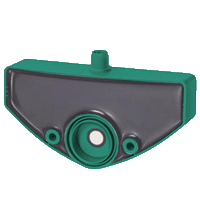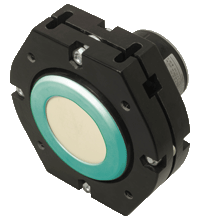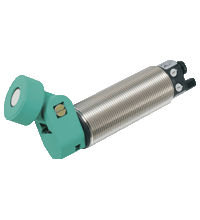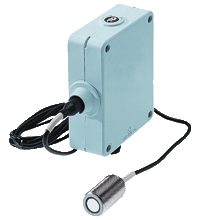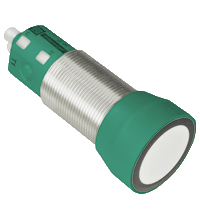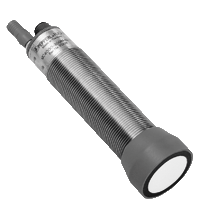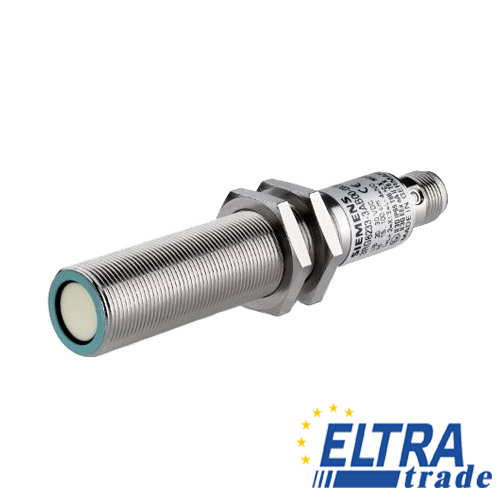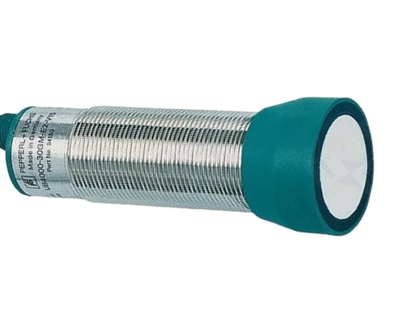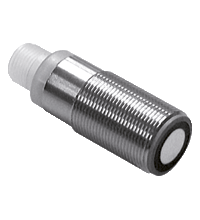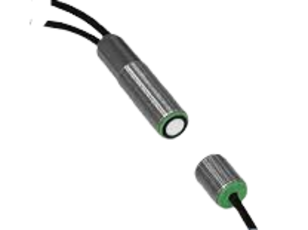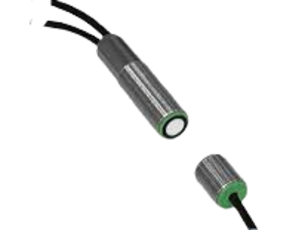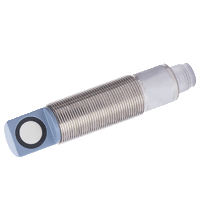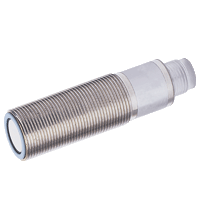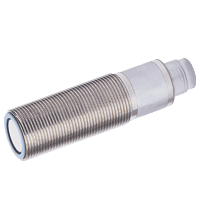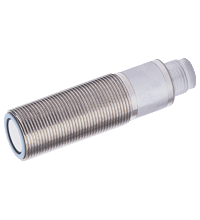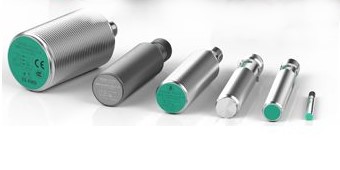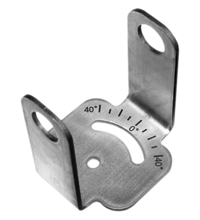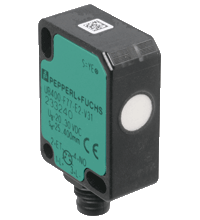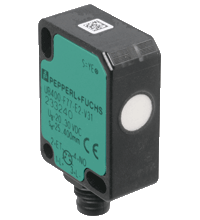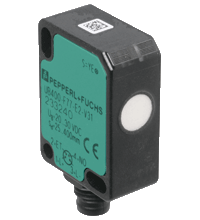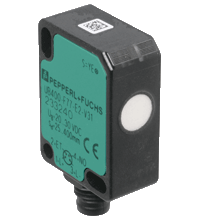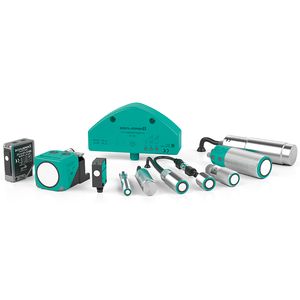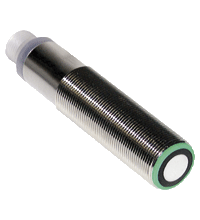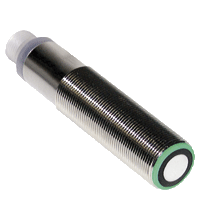Pepperl+Fuchs Ultrasonic Sensors
- Level indication
- 2 switch outputs
- Program input
- Programmable by means of Interface (see accessories) and SONPROG
- Synchronization options
- Temperature compensation
- Large sensing range
- Adjustable Bracket
- Programmable by means of Interface (see accessories) and SONPROG
- 1 analog output, 0-20 mA current source
- 2 switch outputs
- Synchronization options
- Temperature compensation
- Analog output 0 ... 10 V
- 1 switch output
- Synchronization options
- Temperature compensation
- Can be parameterized via the ULTRA-PROG-IR software and interface (accessories)
Ultrasonic sensor
- 4000 mm detection range
- Power consumption 1 W
Ultrasonic sensor
| Sensing range | 50 ... 300 mm |
| Rated ultrasonic frequency | 400 kHz |
| Output voltage | 0 ... 10 V |
- Extremely narrow projection cone
- Analog output 4 mA ... 20 mA
- Very small unusable area
- Measuring window adjustable
- Short response time
UB4000 30GM E4 V15
- Operating temperature: -25 °C ... +70 °C
- Humidity: 35 ... 95% without condensation
- Vibration resistance: 0.35 mm amplitude at 10 ... 500 Hz
- Impact resistance: IEC 68-2-7: 50 g
- Electromagnetic immunity: EN 61000-6-2: 2001
- Short design, 40 mm
- Function indicators visible from all directions
- Switch output
- 5 different output functions can be set
- Program input
- Temperature compensation
UDC 18GM 400 3E1
- Body material: PBT (polybutylene terephthalate)
- Cable type: M12, 4-pin
- Ultrasound frequency: 40 kHz
- Reaction time: ≤ 2 ms
- Hysteresis: ≤ 2 mm
- Vibration resistance: 10 g at 20 Hz
- Shock resistance: 50 g at 11 ms
- Electromagnetic resistance: EN 61000-6-2, EN 61000-6-3
UGB 18GM50 255 2E1
- Operating temperature: -20 ... +60 °C
- Storage temperature: -40 ... +80 °C
- Protection class: IP67
- Shock resistance: IEC 60068-2-7: 20 g vibration at 10 ... 500 Hz
- Impact resistance: IEC 60068-2-31: 50 g, 11 ms
- Electromagnetic resistance: EN 60529/IEC 60529: 2000/11 V/m (EMC)
| Weight | 240 g |
| Ambient temperature | –25...+70 °C |
| Reaching a switch point | ± 1.5% (–25 ° C) |
e5 v1
- Overload protection
- Feedback protection
- Protection against condensation
- Protection against vibration
- Protection against dust
- Protection against moisture
e6r2
- Relative angular range: 60 to 360°.
- Sensitivity: 50 to 200 mV/m
- Pulse power: 30 to 100 mW
- Stability: ±2 mm/h
- Temperature range: -25 to 70°C
- Humidity: 5 to 95% relative humidity
- Protection against condensation: yes
- Protection against dust and water: IP67
- Miniature design
- Program input
- Degree of protection IP67
- Switching status indicator, yellow LED
- Miniature design
- Program input
- Degree of protection IP67
- Switching status indicator, yellow LED
- Miniature design
- Program input
- Degree of protection IP67
- Switching status indicator, yellow LED
- Miniature design
- Program input
- Degree of protection IP67
- Switching status indicator, yellow LED
- 2 switch outputs
- Selectable sound lobe width
- Program input
- Temperature compensation
- Very small unusable area
- 2 switch outputs
- Selectable sound lobe width
- Program input
- Temperature compensation
- Very small unusable area
- Switch output
- 5 different output functions can be set
- Selectable sound lobe width
- Program input
- Synchronization options
- Deactivation option
- Temperature compensation
- Very small unusable area
Ultrasound is sound vibrations that are not perceived by human hearing, with a frequency above 20,000 Hz. With the development of technology, the phenomenon of ultrasound has found wide application in modern life: in industry, medicine, and security activities. So, for example, when measuring the level of a substance, the principle of propagation/reflection of ultrasonic waves is also used.
Ultrasound is often used in industrial process automation systems in the food, oil and gas, metallurgy, energy, and chemical industries, thanks to non-contact material level measurement. Ultrasonic sensors are much cheaper than other non-contact type devices. Today we will discuss Pepperl+Fuchs ultrasonic sensors in more detail.
What is an Ultrasonic Sensor Used For?
Ultrasonic sensors are widely used as proximity sensors, for the remote detection of various objects, and distance measurements. As a rule, sensors operate by sending a short train of ultrasonic waves in the direction of the object to be detected, which, reflected from the surface of the object, returns back. Then, the electronic circuit calculates the time between the moment the signal is sent and the moment the reflected echo is received. Distance is a derivative of time and the speed of sound in the environment.
Currently, the market offers a wide range of ultrasonic sensors in various designs, operating at different acoustic frequencies. The palette of the behavior of different acoustic frequencies in similar environmental conditions is not the same. In most cases, it will not be difficult, guided by the characteristics given by the manufacturer, to select the appropriate sensor for your application.
The ultrasonic transducer emits short high-frequency sound pulses at regular intervals. They travel through the air at the speed of sound. If the pulses collide with an object, they are reflected back to the sensor in the form of echo signals. The device independently calculates the distance to the target based on the time interval between the emission of a signal and the receipt of an echo.
Since the distance to an object is determined by measuring the time of flight and not by sound intensity, ultrasonic sensors are ideal for suppressing background noise. Almost all objects that reflect sound can be detected regardless of their color. Transparent materials or thin foils are also not a problem for ultrasonic waves, as the device is able to see through dust, air, and ink mists. Even thin deposits on the sensory membrane do not impair its function.
How does an Ultrasonic Sensor Detect Objects?
The ability of the ultrasonic sensor to determine the distance to an object is based on the principle of sonar - by sending a beam of ultrasound, and receiving its reflection with a delay, the device determines the presence of objects and the distance to them. The ultrasonic signals generated by the receiver, reflected from the obstacle, return to it after a certain period of time. It is this time interval that becomes a characteristic that helps determine the distance to the object.
The ultrasonic sensor module consists of a transmitter and a receiver. Any sound above 20 kilohertz (20,000 hertz) is considered ultrasound. For this reason, all sounds above the range of human hearing are called ultrasonic. The transmitter emits 40 kHz ultrasonic radiation, while the receiver is designed to receive 40 kHz sound waves only. A receiver sensor close to the transmitter can pick up reflected sound waves when the module hits any obstacle ahead.
Whenever there is an obstacle in front of the ultrasonic module, it calculates the time it takes to send signals and receive them since time and distance are related to sound waves traveling through the air at a speed of 343.2 m/s. After receiving the signal, the display shows the data.
Pepperl+Fuchs Ultrasonic Sensor Calibration
Calibration is one of the most important conditions for effective quality assurance. In the field of measurement technology, sensor calibration refers to the processes used to establish, under certain circumstances, the relationship between the output signal values of a measurement device, such as a sensor or measurement system, and the corresponding values of the measurement device. tool set by the standards.
The sensor must be calibrated in order for the device to work as accurately and error-free as possible. Sensors are electronic components. They are aware of the changes taking place at work. Unwanted output values occur when the sensor environment changes abruptly and unintentionally. As a result, there is a discrepancy between the observed and expected result. Comparing the measured output to the expected output is the sensor calibration process. Calibration is necessary to improve sensor performance. It is used to evaluate structural defects caused by sensors. The difference between the predicted value of a sensor and its measured value is known as structural error.
For more information, you can check out the Pepperl+Fuchs ultrasonic sensor manual.
